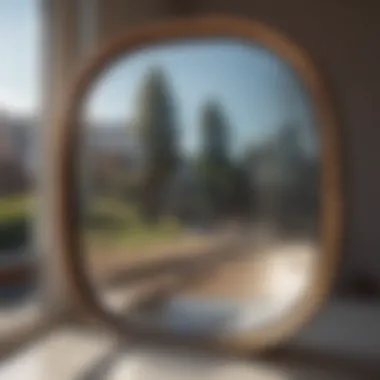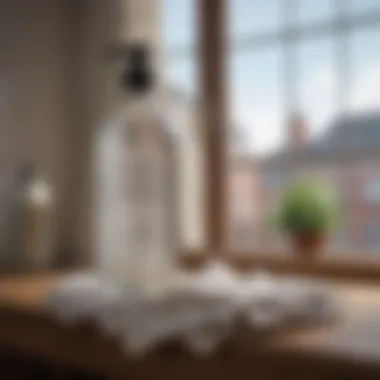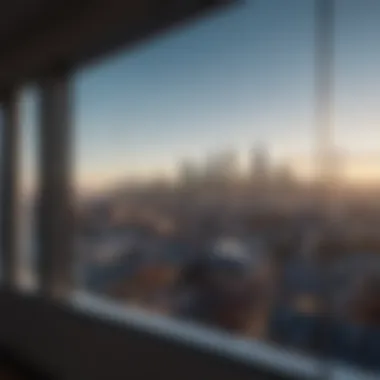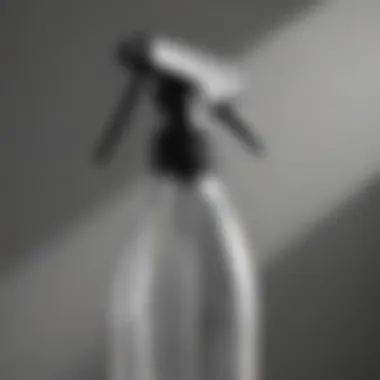Mastering Window Cleaning with White Vinegar


Intro
Cleaning windows is often seen as a tedious task that most people would rather avoid. However, with the right approach, it can be a straightforward and even enjoyable part of household upkeep. White vinegar has emerged as a go-to natural solution for a crystal-clear finish. Not only is it gentle on surfaces, but it also brings a cost-effective alternative to conventional cleaners.
In this article, we'll uncover the myriad of benefits of using white vinegar for window cleaning while guiding you through the steps necessary to achieve sparkling results. This guide is tailored for homeowners and interior design enthusiasts who prefer a more organic way to maintain their spaces.
Benefits of Using White Vinegar
- Eco-Friendly: Unlike commercial cleaners, white vinegar doesn't contribute to indoor air pollution.
- Cost-Effective: A simple bottle of white vinegar is budget-friendly, making it accessible for all.
- Versatile Cleaner: In addition to windows, vinegar can find its place in many cleaning tasks around the home.
As we delve deeper into the world of window cleaning with white vinegar, we'll also touch upon some key considerations to bear in mind, ensuring that your approach is holistic and informed.
Preface to Window Cleaning
When it comes to maintaining a home, clean windows are often an underestimated element. A clear view through your windows not only enhances the aesthetic appeal of your space but also promotes a sense of well-being. It’s a simple yet transformative act that can make your home feel fresher and brighter.
The Importance of Clean Windows
Clean windows offer numerous advantages. Firstly, they allow natural light to flood into our living spaces, creating an inviting atmosphere. Sunlight can elevate your mood and energy levels, something that is especially important in the darker months. Additionally, from a practical standpoint, neglected windows can harbor dirt, grime, and even residual substances from the surroundings. This can lead to deterioration of the glass and surrounding frame over time. Regular cleaning can prevent costly repairs down the road, helping you keep your home in tip-top shape.
Moreover, having spotless windows enhances the overall curb appeal of your property. Whether you are hosting guests or considering selling your home, gleaming windows can leave a lasting impression. In fact, potential buyers often judge a property by its exterior details, and windows play a significant role in that equation.
Understanding Cleaning Agents
Not all cleaning products are created equal. In recent years, there’s been a rising interest in eco-friendly alternatives that go easy on Mother Earth while still providing effective results. Traditional window cleaners can be filled with harsh chemicals that may not only pose a health risk but can also harm the environment. Understanding different cleaning agents helps you make informed choices.
White vinegar stands out as a natural alternative that’s effective and versatile. It can cut through streaks, eliminate hard water stains, and is safe for most surfaces. It’s important to grasp the properties of various agents you’re likely to encounter — not just for windows but across all your cleaning endeavors.
In summary, this introductory section sets the stage for mastering the art of window cleaning with white vinegar. It underscores the significance of both clean windows and an understanding of the agents used, providing a solid foundation for the guidance that follows.
Why Use White Vinegar?
Cleaning windows can seem like a mundane task, but the choice of cleaning agent can elevate the results significantly. White vinegar stands out for several compelling reasons, making it a go-to option for homeowners and design enthusiasts alike. Below, we delve into three major aspects — environmental benefits, cost-effectiveness, and safety considerations — that underscore the importance of using white vinegar in window cleaning.
Environmental Benefits
Using white vinegar is not just about having shiny windows; it aligns with the ideals of environmental sustainability. Unlike common commercial cleaners that may contain harmful chemicals, white vinegar is a natural substance with a lower environmental footprint. It biodegrades easily and does not contribute to air or water pollution.
Moreover, vinegar's acetic acid content effectively cuts through grime and grease without releasing volatile organic compounds (VOCs) into your home. This is particularly crucial for individuals sensitive to such substances. Cleaning your windows with white vinegar supports a healthier living space and reduces your carbon footprint.
"Choosing natural cleaning solutions like white vinegar can transform your cleaning routine into an eco-friendly practice, one window at a time."
Cost-Effectiveness
One of the most appealing aspects of white vinegar is its affordability. A bottle of white vinegar is often significantly cheaper than a specialized window cleaner. By opting for vinegar, you not only save money but also invest in a multi-purpose cleaner that can serve various cleaning needs around your home, making it a true bargain.
- Versatility: In addition to windows, white vinegar can tackle stains on carpets, remove odor from refrigerators, and even de-scale appliances.
- Long Shelf Life: Unlike some cleaning agents that may lose effectiveness over time, a bottle of vinegar can sit in your pantry for months without issue.
Safety Considerations
Safety is a primary concern when it comes to household cleaning products, especially if there are children or pets around. Unlike many conventional cleaners, white vinegar boasts a non-toxic composition. It poses no significant health risks when used properly.
When using white vinegar, there are key considerations:
- No Harsh Fumes: Unlike ammonia or bleach, vinegar doesn't emit harsh odors, making it suitable for indoor use without ventilation concerns.
- Skin Safety: White vinegar is generally safe on the skin, but it’s always smart to avoid direct contact, especially for those with sensitive skin.
Preparing for the Cleaning Process


Getting ready to clean your windows is a crucial step that can’t be overlooked. Proper preparation sets the stage for a successful cleaning session. Not only does it help you to get organized, it can also make the process more efficient and ultimately leads to better results. By gathering the necessary supplies and choosing the right environment, you pave the way for a sparkling finish.
Gathering Your Supplies
Before diving into cleaning, ensure you have all the right tools at your fingertips. Having the right supplies not only saves time but also assures you that your windows will be cleaned effectively. Below are some essential items you’ll need:
White Vinegar
The star of the show, white vinegar is widely known for its powerful cleaning properties. It offers a natural, non-toxic way to scrub away dirt and grime. Not only is it effective at removing streaks, but it also acts to dissolve mineral deposits, making it an excellent choice for window cleaning.
What makes white vinegar especially beneficial is its acidity. The acetic acid present is what does the heavy lifting in terms of breaking down stains. While it’s a bit of an odor shock when first sprayed, it dissipates quickly, leaving behind only clarity. However, keep in mind that its effectiveness diminishes when mixed with certain essential oils, so stick to its pure form for optimal results.
Microfiber Cloths
Microfiber cloths are your best friend when it comes to window cleaning. Unlike traditional rags, these cloths are made from tiny fibers that trap dirt more effectively. They can also absorb water like a sponge, ensuring that your windows dry without streaks.
A key feature of microfiber cloths is their softness. This minimizes the risk of scratching delicate glass surfaces, which is a crucial consideration for maintaining window quality. While they can be a bit more expensive than standard cloths, their durability and efficiency often outweigh the costs.
Spray Bottle
A spray bottle is indispensable in your window-cleaning lineup. It allows for controlled application of your vinegar solution, ensuring you cover every inch of the glass without over-saturating. Easy to fill and handle, it’s designed to provide a fine mist, which is ideal for even distribution of the cleaning solution.
Opting for a spray bottle with a wide mouth is also a smart choice. It makes refilling a breeze, and one with an adjustable nozzle grants you the flexibility between a fine mist and a steady stream, both essential for different tasks in cleaning. Though they may get misplaced, investing in a quality bottle can elevate your cleaning game tremendously.
Rubber Squeegee
The rubber squeegee is the unsung hero of window cleaning. After applying your vinegar solution, using a squeegee helps to remove excess liquid effectively, preventing drip marks and streaks.
A key characteristic of a good squeegee is its blade. A flexible rubber blade performs better, hugging the glass surface so that moisture is wiped away efficiently. It ensures that you’re utilizing the cleaning solution maximally by spreading it out before draining it away seamlessly. While some may find it cumbersome at first, practice makes perfect, and soon you’ll rely on this tool as part of your routine!
Choosing the Right Environment
The cleaning environment can greatly influence your window-cleaning results. Optimal conditions allow for better application of your cleaning solution while minimizing the chances of streaking.
Choose a day when the weather is calm and ideally overcast. This prevents the cleaning solution from drying too quickly, which can leave undesirable streaks. On the flip side, try to avoid windy days, as debris can easily get blown onto freshly cleaned windows.
Step-by-Step Process of Cleaning Windows with White Vinegar
Cleaning windows might seem like a mundane chore, but doing it the right way can make a world of difference. Using white vinegar is not just about achieving gleaming glass; it’s also about developing an effective routine. Following a step-by-step approach ensures that no detail is overlooked, resulting in windows that shine like new. The combination of simplicity and efficiency makes this method appealing, especially for those seeking natural cleaning solutions.
Preparing the Vinegar Solution
Mixing Ratios
The mixing ratio of white vinegar to water is a cornerstone of effective window cleaning. Generally, a mix of one part vinegar to one part water serves as a well-balanced concoction to cut through grime and leave surfaces streak-free. The beauty of this ratio lies in its straightforwardness, allowing anyone to whip up a solution without needing specialized skills.
Too much vinegar can potentially create a stronger smell, while too little might reduce its cleansing power. Many seasoned cleaners agree that sticking to this equal ratio not only optimizes the effectiveness of the cleaner but also keeps the process hassle-free. A distinctive aspect of this mixture is that it works well on both indoor and outdoor windows, maintaining its efficacy regardless of location.
Storage Solutions
Storing your vinegar solution safely is important for prolonging its use. An empty spray bottle is ideal for this task, allowing for easy access and application whenever needed. The key here is to keep it out of direct sunlight, which can weaken the solution over time. A notable advantage of this storage method is the simplicity — you can simply shake the bottle before use to ensure the vinegar and water are well-mixed, ready to restore clarity to your windows.
While the solution itself does not have a long shelf-life, it is super easy to prepare anew whenever necessary. So if you find that the cleaner has lost its sparkle, it’s probably time to freshen it up.
Applying the Solution
The Right Technique


When it comes to applying your vinegar solution, technique matters more than one might think. Many recommend starting at the top of the window and working down. This approach prevents drips from settling on freshly cleaned areas. The ideal technique involves spraying the solution directly onto the glass, allowing it a few moments to break down any stubborn dirt.
After letting it rest, use your microfiber cloth or a squeegee to wipe away the solution. This process makes it easy to observe areas that may need additional attention. The gentle yet firm pressure applied ensures that dirt is effectively removed without scratching the glass, preserving its integrity in the long run.
Window Sections to Focus On
Knowing which sections of the window to clean first can mean the difference between a satisfactory clean and a remarkable one. Start with the panes that are most exposed to dirt, such as those facing a busy street or under heavy tree coverage. Additionally, ensure you also pay special attention to the corners where dirt tends to accumulate.
The beauty of focusing on specific sections lies in its efficiency. By prioritizing the dirtiest parts, you'll maximize your efforts and get the most out of your cleaning session. This approach not only saves time but enhances satisfaction when you see the immediate results of your work.
Wiping and Drying
Using a Microfiber Cloth
Employing a microfiber cloth for wiping is critical. These cloths are known for their ability to attract and trap dust and grime through static charge, making them a more efficient option than traditional rags. Using a microfiber cloth helps in preventing lint from sticking to the window, which can often leave behind frustrating trails. Its durability means you can wash and reuse these cloths, keeping your cleaning routine not only effective but also sustainable.
A unique characteristic is that microfiber cloths work well both damp and dry, which versatility gives you the flexibility to adjust based on the specific window condition you treat.
Utilizing the Squeegee
Finally, employing a squeegee in your cleaning regimen can significantly elevate the overall process. This tool excels in removing excess water, leaving windows spot-free and shiny. The right technique here is to pull the squeegee from the top of the window down in a straight line, wiping the blade with a clean cloth after each pass. This practice eliminates streaks and drips, ensuring a polished finish.
The exclusive advantage of using a squeegee is the time it saves. It quickly covers larger window areas compared to cloth wiping alone. This quality makes it a popular choice for those who have many windows, as it drastically cuts down the effort needed to achieve that pristine look.
Remember, a well-executed process leads to windows you can't help but admire from both the inside and out.
Post-Cleaning Care
After you’ve tirelessly scrubbed those windows till they shine like the stars, it’s easy to feel like the job is done. But taking a moment to return to your handiwork can transform a good clean into a great one. Post-cleaning care is vital for several reasons.
First off, a thorough inspection of your work will help you catch any areas that might need a little extra attention. Did you notice streaks that loomed large against your freshly washed glass? Or maybe a few stubborn spots remained despite your best efforts? Addressing these now will save you time later when you might be staring at those not-so-perfect vistas.
Additionally, this inspection gives you a chance to appreciate your efforts. There’s nothing quite like seeing the world through clear windows after what might have been an arduous task. You did this yourself! Taking a few moments to admire your work can spark a sense of accomplishment and motivate you for future cleaning tasks.
Now, let’s delve into the inspection process.
Inspecting Your Work
Once you’ve completed your window cleaning, grab a step ladder, if needed, and take the time to inspect your work carefully. Look for any noticeable streaks, smudges, or leftover dirt. Using a bright light or even the sunlight can help you spot the areas that might have been missed during cleaning.
Key points to consider during inspection:
- Angles Matter: Observe the glass from various angles; sometimes, imperfections only become visible when looked at straight on versus at an angle.
- Frame Check: Don’t neglect the window frames. A clean window might look amazing, but dusty or dirty edges can detract from the overall aesthetic.
- Use a Cloth: If you spot any streaks or spots, don’t hesitate to grab that microfiber cloth again and do a quick touch-up.
At times you’ll find that a second round of cleaning is in order, particularly in tricky spots like corners or around the edges where grime tends to accumulate. Don’t be shy about giving these areas a little more attention; after all, they contribute to your overall view.
Routine Maintenance Tips
Now that your windows are pristine, let’s talk about keeping them that way. Developing a routine maintenance schedule is crucial for homeowners and design aficionados alike. Here are some tips to maintain the sparkle:
- Regular Cleaning: Aim to clean your windows at least twice a year. However, depending on your environment—if you’re on a busy street, for instance—you might need to increase that frequency.
- Seasonal Checks: The ideal time to clean is during milder months when the temperature isn’t too hot or too cold, reducing the risk of streaks caused by rapid evaporation.
- Stay Ahead of Dirt: If you know a storm is coming or significant pollination happens in spring, make a habit of cleaning windows beforehand. This will prevent dirt and grime from settling onto freshly cleaned glass.
- Squeegee Action: Always have a squeegee handy for quick clean-ups when you encounter drips or spots during inclement weather.
- Keep It Simple with Vinegar: If you find your windows looking less shiny, spritzing them with a diluted vinegar solution can quickly refresh their look without the hassle of a full clean.
Common Mistakes to Avoid
When it comes to cleaning windows with white vinegar, it’s not all sunshine and rainbows. There are several pitfalls that can turn your sparkle into smudges. Acknowledging these common mistakes isn’t just about optimizing your cleaning process; it’s about ensuring you don’t waste time or resources. By steering clear of these missteps, you can achieve the gleaming results you’re after while also prolonging the lifespan of your windows. Here are the critical errors to avoid while employing white vinegar in your window-cleaning routine.
Using Too Much Vinegar


One of the most frequent blunders people make is pouring on more vinegar than necessary. It’s easy to think that if a little is good, then a lot must be better. However, this mindset doesn’t hold up when it comes to window cleaning.
Overdoing it can lead to streaky windows rather than the crystal-clear finish you desire. Too much vinegar can leave a residue—almost like a hazy film—that damages the glass, making it appear dirtier than before. This not only negates your hard work but can lead to frustration that lingers like that stubborn grime.
So, how much vinegar is just right? The golden rule is this: a mixture of one part white vinegar to two parts water typically gets the job done. This simple ratio gives you enough acidity to cut through dirt while keeping it manageable. Always remember, less can indeed be more. \n
Cleaning in Direct Sunlight
Another classic mistake is attempting to clean your windows under the glaring sun. Sure, it seems intuitive to take advantage of natural light when scrubbing away at those glass panes. But, sunlit streaks aren’t just a poetic metaphor—they’re the reality of cleaning windows in the heat.
When you clean in direct sunlight, the heat can dry out your vinegar solution too quickly, leaving behind streaks and spots. Instead of a crystal clear outcome, you may end up with more work than you bargained for. This isn’t just a cosmetic issue; glaring streaks can detract from the ambiance of your home.
It’s best to pick a cooler day or work during the times when the sun isn’t beating down directly on your windows—the early morning or late afternoon can be ideal. This way, your cleaning solution has plenty of time to do its job without rushing to evaporate.
"Patience is the companion of wisdom." – St. Augustine
In summation, avoiding excess vinegar and sidestepping the sun are just two actionable tips that can vastly improve your window-cleaning game. Being mindful of these common mistakes could save you a significant amount of time and annoyance, leading to a sparkling finish that makes your windows the star of the show.
Alternatives to White Vinegar
In the realm of window cleaning, while white vinegar often takes center stage due to its natural and effective properties, it’s wise not to overlook other potent alternatives that can also deliver impressive results. Various factors, such as personal preference, specific cleanliness challenges, or even availability of ingredients, may lead one to consider these alternatives. By understanding the benefits and practical uses of other cleaning agents, homeowners can make informed choices for their cleaning routines. This section aims to highlight options like lemon juice and baking soda that can complement or serve as substitutes for white vinegar in achieving gleaming windows.
Lemon Juice
When pondering alternatives, lemon juice stands out not merely for its fresh scent but also for its impressive cleaning capabilities. Rich in citric acid, lemon juice can effectively break down grime and smudges, making it a worthy contender in the world of natural cleaning solutions. Additionally, it possesses antibacterial properties that add another layer of cleanliness to the surfaces being treated.
Benefits of using lemon juice include:
- Natural Disinfectant: Lemon juice attacks those pesky germs and bacteria that linger on surfaces, adding an extra layer of cleanliness.
- Pleasant Fragrance: The invigorating scent of lemon can transform the cleaning process into a more enjoyable undertaking compared to chemical solutions.
- Streak-Free Shine: Just like white vinegar, lemon juice doesn’t leave streaks, which is essential for maintaining pristine glass surfaces.
However, one needs to be mindful that lemon juice can be slightly more temperamental. If the cleaning environment is particularly sunny, it may cause the juice to evaporate quickly, potentially leaving spots behind. In such cases, it is often recommended to pair lemon juice with a little water to maintain moisture longer during application.
Baking Soda
Another alternative to consider is baking soda, a household staple known for its incredible versatility. Though it’s often thought of for baking, its cleaning prowess cannot be ignored. When mixed with water, baking soda creates an alkaline solution that can neutralize acids, effectively cutting through grime and grease on windows.
Key points about using baking soda include:
- Gentle Abrasive: Baking soda can act as a mild abrasive, which means it can scrub away tough residues without scratching the glass surface. This makes it particularly beneficial for older windows with stubborn spots.
- Odor Absorber: It pulls double duty by also absorbing unpleasant odors, making your space feel fresher after cleaning.
- Eco-Friendly Option: Made from natural ingredients, baking soda is safe for the environment and won’t harm your indoor air quality like some chemical cleaners might.
To use baking soda, create a paste by combining it with a small amount of water. Apply this paste to tough stains on your windows, let it sit for a few minutes, and then wipe it clean with a damp cloth or squeegee for the best results.
Remember, experimenting with these alternatives can be a fantastic way to discover what works best for your individual cleaning needs!
By exploring these alternatives to white vinegar like lemon juice and baking soda, you're equipping yourself with knowledge that could transform your window cleaning approach. Ultimately, finding the ideal method or mixture for your unique situation may not only enhance the cleanliness of your windows but also add a personal touch to your cleaning ritual.
Finale
In wrapping up our exploration of window cleaning with white vinegar, it becomes clear how pivotal this natural solution is in achieving crystal-clear results. Not only does using white vinegar offer a cost-effective method for maintaining the sparkle of windows, but it also aligns perfectly with eco-friendly practices, reducing the reliance on harsh chemicals. The benefits of using vinegar extend beyond just cleaner glass; they touch on aspects of safety, environmental consciousness, and routine upkeep that every homeowner can appreciate.
Recap of Best Practices
To ensure the most effective use of white vinegar in window cleaning, consider the following best practices:
- Mixing Ratios: Always maintain the right vinegar-to-water ratio; typically a 1:1 mixture for optimal cleaning power.
- Clean in the Right Conditions: Avoid direct sunlight while cleaning. It can cause streaks as the solution dries too quickly.
- Use Quality Tools: Microfiber cloths and rubber squeegees help achieve the best results without damaging surfaces.
- Wipe in an Up-and-Down Motion: This technique helps to minimize streaks and ensures even coverage.
Practicing these strategies guarantees a thorough clean and gets you into a rhythm that makes the process feel almost meditative.
"A clear window is a reflection of a tidy mind".
Encouragement for Continued Use
As we’ve discussed throughout the article, the benefits of using white vinegar for window cleaning are numerous. Its application goes beyond just getting the dirt off; it’s about creating an environment that breathes freshness and clarity. Don’t shy away from incorporating this method into your regular cleaning routine—it’s a small change that can lead to remarkable results.
Continue to explore and embrace this natural cleaning agent. Whether you have large bay windows, small bathroom mirrors, or a sliding glass door that needs attention, white vinegar is your dependable ally. As a real estate enthusiast or interior design aficionado, the aesthetic appeal of crystal-clear windows can significantly alter the ambiance of any space—making it an investment in both function and beauty.







